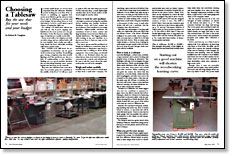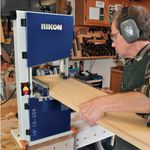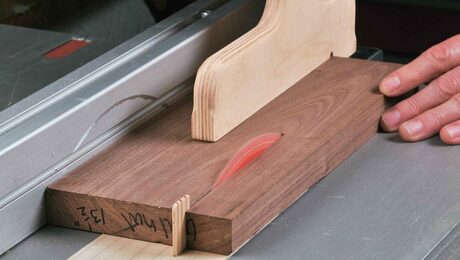Choosing the Right Tablesaw
Buy the saw that fits your needs and your budget
Synopsis: Robert M. Vaughan rehabilitates machines, so he knows a good tablesaw from a poorly made one. He says you’re more likely to get the tablesaw you’re after by defining your needs and budget first. Look at the material you use most often; it’ll tell you the power and accessories you’ll need. Gauge your skill level, and factor in your shop size. He tells you where to look for new machines, whether to consider mail order, and how to look at a tablesaw. He defines what you get for your money, breaking features down by price brackets. He closes with information on buying a used tablesaw.
In many small shops, no tool is more important than the tablesaw. Whether you’re looking for your first 10-in. tablesaw or satisfying an upgrade itch, you’re more likely to get the saw you want if you start by defining your needs—and your budget. By knowing where to look and what to look for, you’ll stand a good chance of buying the right one.
For cutting -in.-thick pine, almost any saw will do. But if you’re ripping 2-in. hardwood, the more power you can get, the better. So the first step is to analyze the type of material you usually work with.
If you work with a lot of plywood, bolton table wings and an outfeed table will be very helpful. And a hefty saw with a long, sturdy rip fence will make working with heavy panels easier.
Also, consider your skill level. An accomplished woodworker can do good work on almost any machine. If something goes wrong, a beginner may have trouble figuring out if the problems are due to a lack of craftsmanship or the machine. Starting out on a good machine shortens the woodworking learning curve, assuming the saw has been set up correctly.
Shop size also will factor into your decision. Do you have space for a machine in the middle of the floor? Or will you need to push it off to the side when not in use? For the truly tiny shop, a small, lightweight machine that can be stored under a workbench might be just the ticket.
Where to look for new machines
I strongly recommend seeing the machine before making any buying decisions. Hardware stores and home centers are good places to find medium-to-low range machines. Higher-quality machines are sometimes found at home centers and large hardware stores but more likely at industrial distributors. The biggest problem with looking at any new machine on a showroom floor is that you may not be able to try it out.
One way to get around this problem is to finagle an invitation to someone’s shop. A manufacturer or distributor may know a customer who is willing to show off his equipment.
From Fine Woodworking #112
For the full article, download the PDF below:
Fine Woodworking Recommended Products

Rikon 10-3061 10-in. Deluxe Bandsaw
The saw has two speeds: 3,280 sfpm (surface feet per minute) for wood and 1,515 sfpm for soft metals and some plastics.

Ridgid EB4424 Oscillating Spindle/Belt Sander

Ridgid R4331 Planer





















Log in or create an account to post a comment.
Sign up Log in